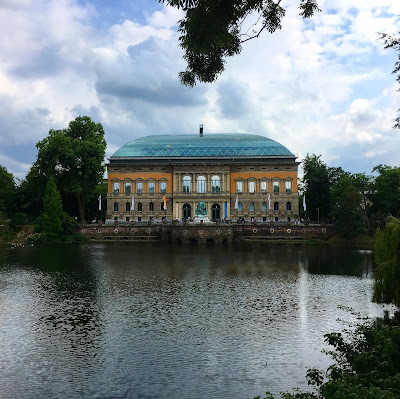We’ve been planning a visit to K21, Düsseldorf’s top notch contemporary art gallery, for a while. The K20, its sister gallery, gets a lot of the attention for its collection of classic and modern German art, but K21 is an interesting visit for those ready to brave the occasional strangeness of contemporary art.
Full disclosure, I’m not a big contemporary art nut.
Sometimes I'm impressed with it. Other times I wonder if a six-year-old could have done the same thing. I don't hide my ignorance about it. I try to appreciate the artist for coming out and doing something that wasn't done before, which is the barest minimum we can all do when looking at art.
K21 is big for a contemporary art space. And it's a gorgeous old building too. Usually you don't see that, but Düsseldorf was Joseph Beuys’ hometown, so there must be a civic bias for absurd, contemporary artsiness.
Side note, Beuys is famous for a few things, like his tin cans, but after a visit to his exhibition at Ottawa's National Gallery, my favourite Beuys is a cross with a sausage hanging from it.
Sometimes I'm impressed with it. Other times I wonder if a six-year-old could have done the same thing. I don't hide my ignorance about it. I try to appreciate the artist for coming out and doing something that wasn't done before, which is the barest minimum we can all do when looking at art.
K21 is big for a contemporary art space. And it's a gorgeous old building too. Usually you don't see that, but Düsseldorf was Joseph Beuys’ hometown, so there must be a civic bias for absurd, contemporary artsiness.
Side note, Beuys is famous for a few things, like his tin cans, but after a visit to his exhibition at Ottawa's National Gallery, my favourite Beuys is a cross with a sausage hanging from it.
Anyway, back to our K21 visit
We wandered into an exhibit with a light show in a mirrored box. In another, we approached what we thought was a red rectangular screen, only to reach out and discover it was an optical illusion. It was actually a room with a curved back wall lit by red LEDs. The curved wall, without corners, tricks your eyes into thinking your looking at something without depth, like a screen. Clever, tricky Contemporary Art!
K21's biggest draw is a creation by Tomas Saraceno: an elaborate web of steel cables suspended above the building’s atrium. Visitors put their belongings into a locker, don coveralls and hiking shoes, and walk or lounge on the steel cables, looking four floors down onto the atrium below.
It’s amusement park-esque, but there is a typical contemporary art explanation about how people’s actions affect other people. That's actually not bullshit. When you walk along, especially if you're a clumsy bag of bones like me, other people have to steady themselves as the web shakes and strains and shifts beneath them.
Wandering through a contemporary art exhibit sometimes leaves me wondering what I just saw, it's also nice to know that contemporary art can also surprise and delight me too.





